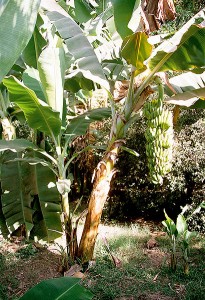
Currently we consume 400 million tonnes of paper yearly. We also keep using chipboard that emits hazardous components. What if there was a solution to both of those problems?
Australian company Papyrus Australia has just won a Cleantech award and, man, they deserve it. Over the last two decades they’ve bee busying themselves with developing a unique technology that allows processing banana plant fibres into a wide sort of valuable stuff. Banana tree trunk is a pseudo stem that re-grows twice a year without requiring any extra effort. Now, when you grow bananas, you just reap the harvest and leave the stems to rot! It is possible to derive a great fibrous material from the “waste” trunks.
Papyrus Australia states on their website that their intention is NOT to belittle the efforts of the conventional paper making industry. Fair enough, there’s nothing wrong with a polite approach. Yet it is not my intention so I will go and say everything I want about the current paper making industry. It:
- cuts the trees wherever it can find some
- uses huge amounts of energy and water to convert trees into paper
- uses bad chemicals in the process
- produces huge amounts of waste-water, which, if not filtered properly cause problems for river ecosystems.
The new Australian technology doesn’t consume water (actually it produces water as a by-product), it uses few chemicals and it doesn’t interfere with forestation. Look at it this way: there are banana plantations, like it or not, they produce millions of tonnes of waste stems continuously – that waste can be turned into paper and green building material. Great!
Banana fibres can be used to produce: office paper, cardboard (both structural and functional), decorative veneer, structural veneer, laminates for green building industry and furniture. Some products can be made water resistant and flame retardant.
The idea of using fibre to produce paper is more than 5,000 years old. Ancient Egyptians learned to make papyrus using fibre from Papyrus Cyperus plant around year 3700 BCE. Today many of the fancy Egyptian souvenirs are made from banana fibres not from Cyperus.
If common sense wins over lobbying and bureaucracy, this might be just what we need to save the forest!
I have been a shareholder in this company for a few years now. It is not only the benefit of reducing the ammount of pulp paper we use now. Imagine all those third world countries that grow bananas now have a valuable cash crop that is worth millions of dollars. The machine to do all this is also portable,so no having to truck the fibre thousands of miles, only the end product that is dried, and so weighs a fraction of what it did before it was manufactured this means they cut out a lot of the pollution from the transport angle.
A quote I saw in the paper here summed it up beautifully it went something like:
“they have more green cred than a bycicle riding vegan with a worm farm.”
Mario, thank you very much for your valuable comment. I love the quote 😀
This banana thing sounds really great. I think it will also mean a better life for the “plantation people”!
I’d like to ask you a few questions about the shares, hope you don’t mind me emailing you.
No problem. The company has announced that they will be making a version of particle board and MDF( I think from the waste after they extract the veneer). Imagine a particle board substitute that is water retardant and fire retardant !. Just so you know, these are not pie in the sky ideas. The prototypes do exist and are being tested as we speak. I actually have a sample of the veneer. looks exactly like wood veneer but without the knot holes, so in my opinion looks better.
For anyone interested in this technology, there was a segment on national tv here on 19/04/10
If you wish to view it, it is here:
http://www.abc.net.au/landline/
Then click on the story titled “Pick of the bunch”
Veneers may not look good for everyone, just look at Hilary Duff.;~”
LOL! I bet her veneers are not eco-friendly! 🙂